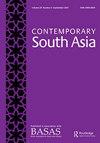Networks, space and belonging: the Marwaris in Manipur
IF 0.8
3区 社会学
Q3 AREA STUDIES
引用次数: 1
Abstract
ABSTRACT This article aims to supplement existing economic analyses of the Marwari mercantile network by exploring how the network is both grounded spatially and reproduced culturally in Manipur. It discusses some of the economic and socio-cultural practices adopted by the Marwari merchants in Manipur including their business activities, marriage patterns and temple construction. In so doing, it highlights the nature of relationships between these practices and how they are connected to their mercantile network at large. The article also illustrates how merchant communities such as the Marwaris carve out their own space through cultural processes of place-making in a contested place like Manipur. Elucidating how the Marwari mercantile network gets reproduced culturally, it reveals the ways in which networks of capital relate to distinct spatial configurations – in this case, borderland. In turn, the above process also delineates how the idea of belonging for the Marwari merchants is emplaced and shaped at the same time by their mercantile network. Based primarily on interviews, observation and some documents, the materials used in this article stem mainly from Imphal and some from Churachandpur.网络、空间和归属:曼尼普尔的马尔瓦尔人
本文章由计算机程序翻译,如有差异,请以英文原文为准。
求助全文
约1分钟内获得全文
求助全文
来源期刊

Contemporary South Asia
AREA STUDIES-
CiteScore
2.10
自引率
0.00%
发文量
82
期刊介绍:
The countries of South Asia - Bangladesh, Bhutan, India, Maldives, Nepal, Pakistan and Sri Lanka - are internally diverse and part of global flows of people, goods and ideas. Contemporary South Asia seeks to address the issues of the region by presenting research and analysis which is both cross-regional and multi-disciplinary. The journal encourages the development of new perspectives on the study of South Asia from across the arts and social sciences disciplines. We also welcome contributions to pan-regional and inter-disciplinary analysis. Our aim is to create a vibrant research space to explore the multidimensional issues of concern to scholars working on South Asia and South Asian diasporas in the postcolonial era.
 求助内容:
求助内容: 应助结果提醒方式:
应助结果提醒方式:


